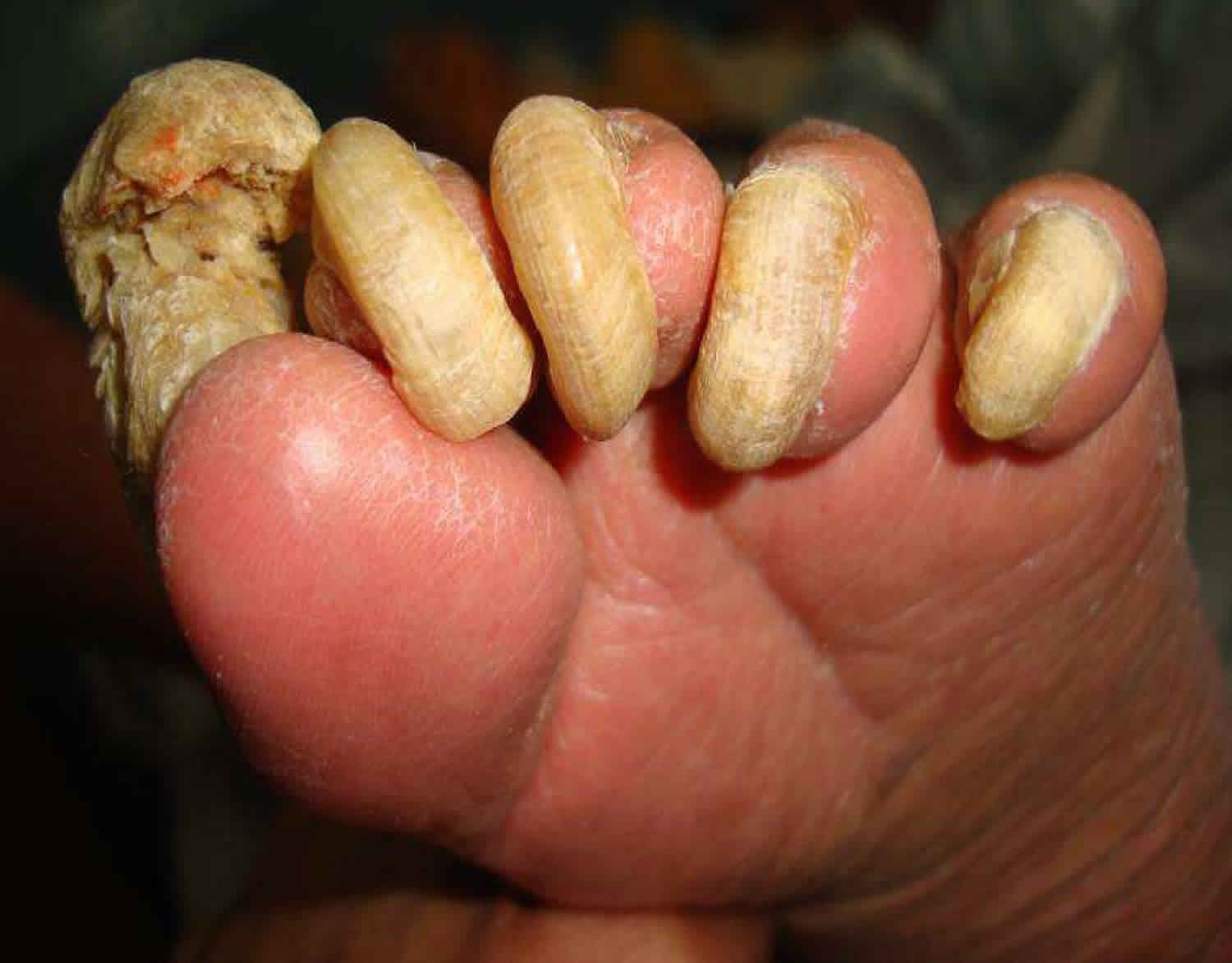Onychogryphosis
Onychogryphosis also known as ‘Ram’s horn’ nail, is a thick hard curved nail plate in the shape of a ram’s horn 1. Onychogryphosis is a form of nail disorder resulting from slow nail plate growth. Onychogryphosis is characterized by an opaque, yellow-brown thickening of the nail plate with elongation and increased curvature 2. Onychogryphosis is more often observed in older people, people with poor personal care, and patients with senile dementia 3. Onychogryphosis is a relatively common and important condition because patients may suffer from pain, secondary complications, and cosmetic concerns.
Definitive treatment for onychogryphosis is nail avulsion followed by matricectomy or surgical resection of the nail matrix 1.
Figure 1. Onychogryphosis
Onychogryphosis causes
The exact cause of onychogryphosis is not completely known. There have been a few reports of congenital onychogryphosis, which is inherited in an autosomal dominant fashion, affects all nails and occurs within the first year of life. Acquired onychogryphosis is more common 1.
Onychogryphosis is associated with:
- Skin diseases such as ichthyosis, psoriasis, pemphigus, tertiary syphilis, hyperuricaemia (the cause of gout) and in the past, smallpox
- Poor peripheral circulation, which may be associated with diabetes mellitus
- Traumatic injury to the nail bed
- Microtrauma due to poorly fitting shoes
- Hallux valgus (bunion) 1.
In onychogryphosis, the nail plate becomes hypertrophied and uneven at the proximal matrix (the nail growth plate). The direction of the deformity is determined by which side grows faster, either due to an insufficiency of the nail matrix under the proximal nail fold or because the nail bed produces a greater quantity of keratin than normal 1.
Onychogryphosis symptoms
The clinical features of onychogryphosis include:
- Involvement of one or both great toenails
- Opaque, yellow-brown thickening of the nail plate with elongation and increased curvature
- Often described as resembling a ‘ram’s horn’ or being ‘oyster-like’ in appearance
- The nail plate initially grows upwards and deviates in a lateral direction
- The nail bed exhibits an irregular surface, marked by longitudinal and more frequently, transverse striations.
Onychogryphosis complications
The complications of onychogryphosis may include:
- An ingrown toenail
- Paronychia
- Secondary onychomycosis (fungal nail infection)
- Rarely, subungual gangrene.
Onychogryphosis diagnosis
Onychogryphosis is clinically diagnosed based on its characteristic appearance 1. In the early stages, it can be somewhat difficult to recognise, as the only feature is hypertrophy of the nail plate and the classical features usually appear in the later stages 1.
On histology, the keratinocytes appear disorderly and there is associated hyperchromatism, parakeratosis, and numerous splits 1.
Onychogryphosis differential diagnosis
The differential diagnosis for onychogryphosis includes:
- Congenital malalignment of toenails (lateral deviation of the nail plate that is not parallel to the major axis of the distal phalanx, usually present in infancy or childhood) 4.
- Pachyonychia congenita, in which the fingernails are more commonly affected, and the thickened nail has a brownish discolouration (molecular genetic studies can be done to detect mutations in keratin genes K6a and K16)
- Onychomycosis, which can co-exist with onychogryphosis (nail clippings should be undertaken to culture dermatophyte fungus, yeast, or mold) 5.
Onychogryphosis treatment
Treatment for onychogryphosis can be either conservative or operative depending on its cause and symptoms 1.
The patient should avoid excessive pressure or microtrauma to the nail bed by selecting properly fitted footwear 1.
Conservative treatment involves:
- Regular use of an electric drill, bur, or mechanical debridement with a nail clipper to shorten the nail and remove subungual hyperkeratosis
- Cryotherapy prior to debridement will soften the nail plate so it is easier to cut
- Blunt dissection with a nail clipper after medical nail avulsion with either 40% urea or 50% potassium iodide 1.
If conservative treatment fails, nail avulsion followed by matricectomy may be considered by excision or ablation 1:
- Excisional techniques include scalpel excision, cutting electrosurgery, or laser in cutting mode 1.
- Ablative techniques include chemical cautery, electrosurgery, or laser in ablative mode 1.
The Zadik technique or a V-Y advancement flap can be used to completely remove the nail matrix 1. The Syme method, whereby half of the terminal phalanx is removed with the nail fold, is rarely used 1.
Onychogryphosis prognosis
Onychogryphosis tends to recur after conservative treatment 1. For both clinical and cosmetic purposes, treatment can be repeated to keep the nail bed short and prevent any secondary complications. The use of proper footwear to prevent excessive nail pressure on the nail bed is important.
References- Ko D, Lipner SR. Onychogryphosis: Case Report and Review of the Literature. Skin Appendage Disord. 2018;4(4):326–330. doi:10.1159/000485854 https://www.ncbi.nlm.nih.gov/pmc/articles/PMC6219229
- Chang P. Onychogryphosis. Our Dermatology Online 2011; 2: 227–8. http://www.odermatol.com/wp-content/uploads/2011/09/13.-Onychogryphosis.pdf
- Chang P, Meaux T. Onychogryphosis: a report of ten cases. Skinmed 2015; 13: 355–9.
- Cataflo P, Musumec ML, Lacarrubba F, Dinotta F, Micali G. Congenital malalignment of the great toenails: a review. Skin Appendage Disorders 2018; 4: 230–5. doi: 10.1159/000484943
- Singh G. Nails in systemic disease. Indian J Dermat Venereol Leprol 2011; 77: 646–51.





